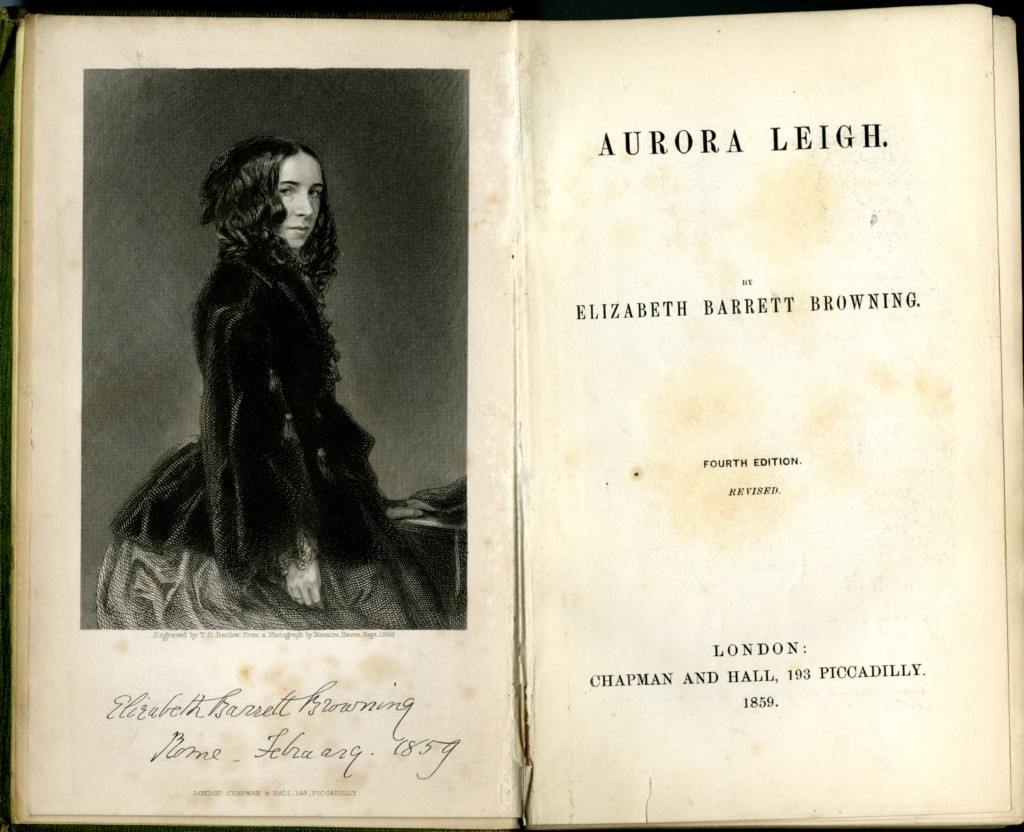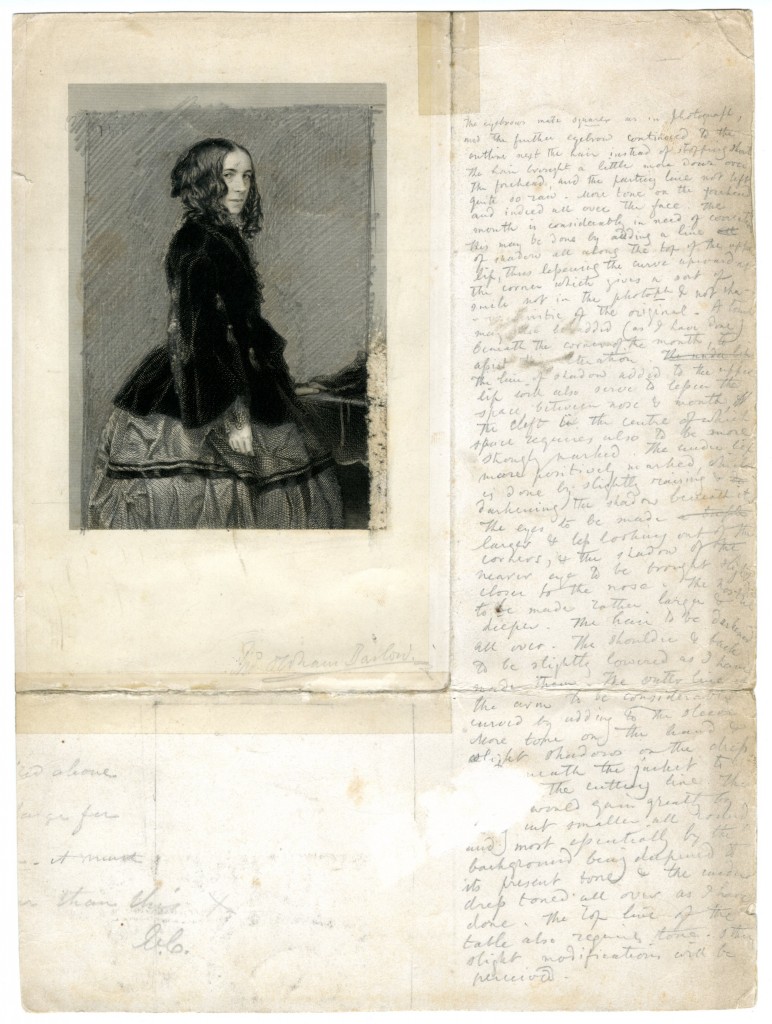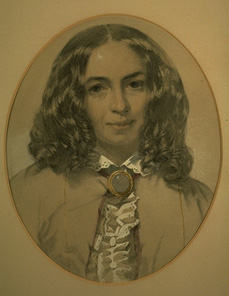Elizabeth Barrett Browning, Aurora Leigh, 4th ed. inscribed to W. M. Rossetti from the Authoress with frontispiece of EBB (Browning Guide C0013.1)
EBB engraving for the 4th ed. of Aurora Leigh touched up by Dante Gabriel Rossetti. Engraving by T.O. Barlow based on a photograph by Louis Cyrus Macaire (Browning Guide L0229)
Colored chalk drawing of EBB by Eliza Fox-Bridell, 1858. Hanging in the EBB Salon at the Armstrong Browning Library (http://www.browninglibrary.org/index.php?id=48563)
Rare Item Analysis: Images of Elizabeth Barrett Browning
by Megan Van Horn
Around the year 1863, Robert Browning sent a photograph of his wife to William Michael Rossetti to be engraved and included in Aurora Leigh. William Michael Rossetti gave the picture to a man named Barlow to engrave. Upon receiving the proof-engraving, Dante Gabriel Rossetti wrote out a number of suggestions and penciled in changes to be applied before its publication in Aurora Leigh. This proof-engraving is housed in the Armstrong Browning Library, Browning Guide L0299. William Michael notes on the back of this document that he believes that all the changes requested by Dante Gabriel were carried out. This proof-engraving shows the way Elizabeth Barrett Browning was perceived in her time and the way contemporary artists tried to shape her image.
One of the things Dante Gabriel focuses on most in his notes is Elizabeth Barrett Browning’s face. He tells the engraver to change the mouth in order to eliminate the smile that he notes is “not characteristic of the original.” Her eyes are also critiqued. Dante Gabriel asks that they be made “larger & less looking out of the corners.” He goes on to instruct Barlow to add “more tone… all over the face.” Dante Gabriel takes great care to ensure his vision of EBB comes to life. By changing her mouth, he gives her a more serious expression fitting for an author who deals with serious issues in her society. By denying the womanly smile, Rossetti refuses to allow EBB to be categorized as merely a woman writer. Instead she is a Victorian poet whose poems have a significant influence on society. The change in her eyes gives a similar effect. By having EBB stare directly towards her audience instead of glancing to the side, she takes on a more authoritative quality.
Another significant change Rossetti makes is changing EBB’s posture. On the proof-engraving that he edited you can clearly see marks where Rossetti erased parts in order to give the appearance that EBB was standing in a more upright and confident position rather than the slouched position portrayed by Barlow in the proof-engraving. This change works with the other changes Rossetti makes to make EBB appear as a powerful and legitimate figure in the world of literature.
Moving on to the rest of the engraving, Rossetti notes that the print “would gain greatly by being cut smaller all round” and asks that Barlow also deepen the tone of the background. Both of these changes pull a viewer’s focus back towards the subject of the engraving, EBB. Rossetti suggests several other ways of pulling focus back to Elizabeth herself. He asks that her dress tone be deepened and tells Barlow to remove the “cutting line” of her clothing. These changes soften the engraving, making the audience focus on the only thing in the engraving that is clear, Elizabeth’s face. The changes Rossetti makes to her image all work to make her look younger and more conventionally attractive.
It is interesting to note that all of the people working on this image of Elizabeth were men. It was her husband, Robert Browning, who sent her photograph (taken by two men, Louis Cyrus Macaire and Jean-Victor Macaire-Warnod) to William Michael Rossetti; it was a man, Barlow, who made the engraving; and it was another man, Dante Gabriel Rossetti, who determined the final outcome of her appearance that was shown in Aurora Leigh. Elizabeth had very little influence on the image created for her by men.
Another portrait of EBB by artist Eliza Fox-Bridell shows Elizabeth as interpreted by a female. The lines are softer, partially owing to the medium of chalk, and the face is made to look very soft and young. While Elizabeth seems to have approved of the hair in this portrait, in a letter to a friend she wrote, “For the likeness you shall judge for yourself.” This suggests that Elizabeth did not necessarily believe that this was the most accurate depiction of herself. Instead, most of the images we have of her are subject to the interpretation of artists. As seen by Dante Gabriel Rossetti’s notes on her engraving, an artist can make many changes that dramatically change the appearance of a subject. Ultimately artists in her time portrayed Elizabeth in different ways, viewing her as both a serious force in the poetic community and as a woman. This item could be used to compare the way contemporary artists perceived Elizabeth in contrast with the way she inserts her own image in her writings.
For further analysis on some of these images see this previous post: https://blogs.baylor.edu/19crs/2016/01/21/artifacts-related-to-ebbs-aurora-leigh/

 |
 |
 |
 |
